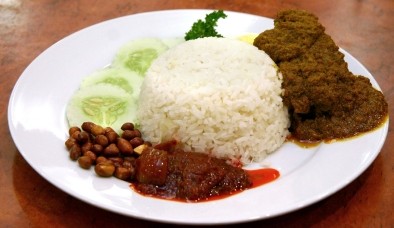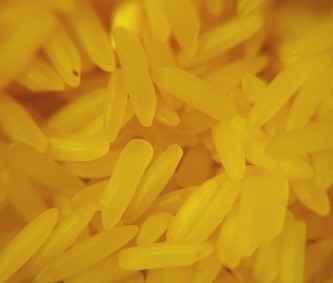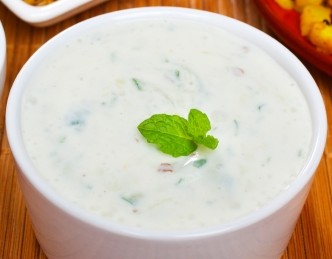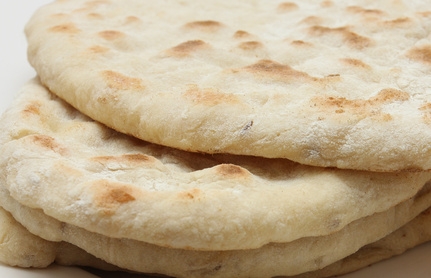By Dave DeWitt
Recipes:Coconut Milk Rice Saffron Rice Cucumber Salad Spicy Indian Salad Mango and Coconut Chutney Apple and Raisin Chutney Naan Chapatti
|
And what dishes should be served with the curries in this series? Most curries are served with some form of rice, and plain white rice is an excellent accompaniment to most curries. I have given recipes for two exotic rices found in various parts of the world. I have also included some non-curried side dishes and breads that go with curries, and they can accompany curries from all over the world, so cooks are encouraged to experiment with various combinations.
The condiments are usually either served in bowls, so that guests may sprinkle them over the curry, or are placed on the side of the individual dishes. Additionally, here is a general list of basic condiments often served with curries worldwide: fried eggplant, tamarind jam, candied coconut, candied ginger, pickled vegetables (such as onions), mango chutney, grated fresh coconut, grated roasted coconut, chopped peanuts or almonds, grated or slice hard-boiled eggs, chopped crisp bacon, chopped tomatoes, and salted fish.
Curry and Beverages
The curry controversy continues when the question comes up about what drinks to serve with curries. Of course, many non-alcoholic drinks can be served with curries, including milk to cool them down. But the controversy arises with alcohol.
“Curries present a perplexing problem,” writes John Phillips Cranwell. “Most of them come from countries whose population is predominately Muslim or Hindu. To both alcohol is forbidden, hence little indigenous wine exists. I enjoy beer, or ale with curry, or even a rough red wine.” Cranwell was right about Muslims, but wrong about Hindus, who have no restrictive laws regarding alcoholic beverages.
Many writers believe that wine and curries simply do not work together. William Templeton Veach and Helen Evans Brown, authors of A Book of Curries and Chutneys, warn: “It is a mistake to serve wine with curry. Wine is quite foreign to the nature of the dish, and even if the combination were perfectly digestible, the spices of the curry would completely mask the bouquet and flavor of the wine.” Noted oenologist Andre L. Simon agrees: “I do not know of any wine that can be happily partnered with curry.” Another wine expert, Roy Andries de Groot, explains: “The most exotic menus reach their climax with the incendiary, mouth-burning torrid curries in which the black, green, and red chiles are the masters. When the dish is a Malaccan Devil’s Curry…we are whistling in the dark to hope that wine can be anything more than secondary. Yet the right wine, if it has a clear enough character to cut through the heat, will refresh the mouth and help separate and balance the flavors….” De Groot goes on to recommend sparkling wines from California and the Alps.
Harvey Day generally agrees with the wine prohibition, although he concedes that a good champagne is acceptable on “a very special occasion.” He is supported in this contention by English curry expert Pat Chapman, who writes: “The facts are simple: wine, red or white, is perfectly acceptable with curry. The more delicately spiced the dish, the more sophisticated can be the wine. My personal favorite with curry is pink champagne or sparkling wine.” He does acknowledge, however, that “fine wines are wasted…their subtlety is overpowered even by mild spicing.” Chapman concludes succinctly: “Wining and dining is for enjoyment–rules are for fools.”
New York wine connoisseur Peter Grieg throws a ringer into the debate: “Although I am quite sure that curry in any form is too pungent a flavor for all wines, why should not a long rum drink complement the dish excellently well, especially in spring and summer?”
 The British in India commonly drank ginger beer with curries, and beer of all kinds seems to be the universally accepted alcoholic drink to accompany curries worldwide. “Generally speaking,” observed Harvey Day, “light beers are the best beverages to drink with or after curries.” He went on to note: “If you fancy a Guinness before, and a vintage port after your meal of curry and rice–and if it agrees with you–then to perdition with the Food and Wine Society!”
The British in India commonly drank ginger beer with curries, and beer of all kinds seems to be the universally accepted alcoholic drink to accompany curries worldwide. “Generally speaking,” observed Harvey Day, “light beers are the best beverages to drink with or after curries.” He went on to note: “If you fancy a Guinness before, and a vintage port after your meal of curry and rice–and if it agrees with you–then to perdition with the Food and Wine Society!”
Later studies indicate that Day was correct. Statistics collected in 1991 by The Curry Club, a British organization devoted to curry, show that the favorite beverages ordered by diners at curry restaurants were as follows: lager, 45%, wine 21%, beer 20%, non-alcoholic, 14%. In fact, beer is so popular with curries in the U.K. that Cobra Indian Lager is a major sponsor of a guide to the best curry restaurants.
For curry purists, there is one possible solution to the problem of what to drink: Turtle Lady Curzon. This beverage was named for Lady Curzon, Vicereine of India from 1899 to 1905, and consists of one cup of turtle consomme, one-half teaspoon of curry powder, and cream to taste. It was a popular drink aboard the Queen Elizabeth, but, not surprisingly, is hardly ever served today.
Anyway, not all the curry controversies can be definitively resolved. The ultimate decision as to what curries are, how to cook with them, and what to serve with them is up to the individual cook. I simply hope that the recipes in this series will cause cooks to develop their own strong opinions about the nature of curries–and what to serve with them.
Coconut Milk Rice
(Nasi Lemak)

Here is the most popular rice dish on the Ist coast of Malaysia. It is served in coffee shops and roadside stands, wrapped in banana leaf and garnished with a sambal, peanuts, egg, and cucumber slices. It is a perfect side dish with any of the curries in this series, as shown above. Thin the coconut milk with an equal amount of water for a less pronounced coconut flavor in the rice.
2 cups long grain rice, washed and drained
3 1/2 cups coconut milk
1/2 teaspoon salt
1 teaspoon butter
2 whole cloves
2 pandan leaves (screwpine), tied in a knot (optional)
Combine all ingredients in a pot and bring to a boil. Reduce the heat to simmer, cover the pot, and cook until the rice is done and fluffy, about 35 to 40 minutes. Remove the cloves and screwpine leaves before serving.
Yield: 6 to 8 servings
Saffron Rice

This striking curry accompaniment can be made with either saffron or turmeric. This version is made pilaf-style, but it can also be cooked on top of the stove. It can accompany any curry in this series.
1/4 cup butter or ghee
1 cup long-grain rice
2 cups homemade stock of choice (beef, chicken, fish)
1/4 teaspoon crumbled saffron (or substitute 1/2 teaspoon turmeric)
1 cup raisins
1/2 teaspoon ground cinnamon
1 teaspoon brown sugar (optional)
Heat the butter in a skillet and saute the rice over medium heat until it is golden brown, about 5 to 6 minutes. Add the stock and bring to a boil.
Immediately remove from the heat and stir in the remaining ingredients. Transfer to a ceramic baking bowl and bake, covered, at 350 degrees F. for 45 minutes. For a crispier rice, remove the cover during the last 15 minutes.
Yield: 4 servings
Cucumber Salad with Yogurt
(Raita)

Raitas are combinations of vegetables or fruits with spiced yogurt that accompany curries. In some cases the ingredients are pureed together to make a thick drink. This fragrant version is more like a salad and can be enjoyed with any curry dish is this series. It is widely served across Sri Lanka with coconut milk; in northern India, it is prepared with yogurt and lessened amounts of spices. An option here is to add one chopped tomato and increase the yogurt or coconut milk by one-third cup.
2 cucumbers, thinly sliced
1 large onion, thinly sliced
1/4 teaspoon cayenne powder
1/2 teaspoon coriander powder
1/2 teaspoon cumin powder
1/2 teaspoon powdered ginger
1/2 teaspoon fenugreek seeds (optional)
2 tablespoons freshly squeezed lime juice
1 cup yogurt or coconut milk
Salt to taste
Mint leaf for garnish
In a large bowl, combine all the ingredients and refrigerate for an hour before serving.
Yield: 4 servings
Heat Scale: Mild
Spicy Indian Salad

This is a refreshing and easy-to-make salad from a New Delhi restaurant; the cook traded the recipe for a bottle of beer and fried chicken in a nearby ritzy restaurant.
2 tablespoons vegetable or olive oil
1 teaspoon mustard seeds
1 teaspoon cumin seeds
1/2 teaspoon fenugreek seeds
1 red chile, such as serrano, stem removed and minced
1 cucumber, peeled and cut into thin slices
2 tomatoes, sliced
1 onion, sliced into rings
1 1-inch piece of ginger, peeled and finely minced
1/4 cup sour cream
1/4 cup unsweetened yogurt
1/2 teaspoon salt
1/4 cup cilantro or mint leaves for garnish
Heat the oil in a skillet over medium heat for 1 minute. Add the mustard seeds and when they begin to pop, after about 1 minute, lower the heat, add the cumin and fenugreek seeds and red chile, and fry for half a minute. Set aside.
In a bowl, combine the cucumber, tomatoes, onions, ginger, sour cream, yogurt, and salt; mix thoroughly.
Pour the mixure from the skillet into the salad and mix well. Garnish with cilantro or mint leaves.
Yield: 4 servings
Mango and Coconut Chutney

This chutney from the southwest coast of India can be served with any curry in this series and can be used as a dip for any kind of chip, including fried plantains.
1/2 cup water
1 small ball tamarind pulp (or 1 teaspoon lime juice)
1/2 cup warm water
1 cup shredded coconut
1 1-inch piece ginger, grated
2 green chiles, such as serranos, stems removed and halved
2 cloves garlic
1/4 cup minced cilantro
3 large green mangoes
1/2 teaspoon cumin seeds
1/2 teaspoon fenugreek seeds
2 tablespoons olive or vegetable oil
1/4 teaspoon mustard seeds
1/2 teaspoon asafoetida
1/2 teaspoon greengram dal
1/2 teaspoon red chile powder
1/2 teaspoon turmeric powder
1/4 cup curry leaves (optional)
1/4 cup cilantro leaves
Salt to taste
In a cup, soak the tamarind in 1/2 cup warm water for 10 minutes, then strain the pulp and save the liquid.
In a blender, grind into a fine paste the coconut, ginger, chiles, garlic, cilantro. Combine the paste with the tamarind water. Set aside.
Peel the mangoes, discard the seeds, and grind the pulp in a blender or food processor along with the cumin and fenugreek into a smooth paste.
Heat the oil in a large skillet over medium heat for 2 minutes. Reduce the heat, add the mustard seeds, dal, and asafoedita. When the seeds begin to pop, add the mango paste, chile powder, turmeric, and coconut-tamarind paste. Add a little water, mix well, and cook over low heat for 10 minutes, stirring occasionally.
Remove from the heat and add the curry leaves, cilantro, and salt. Place in a jar in the refrigerator; it keeps for at least three months.
Yield: 2 to 3 cups
Heat Scale: Medium
Apple-Raisin Chutney

This South African chutney is notable for its lack of exotic ingredients and its versatility–it goes well with any curry in this series.
3 pounds apples, peeled, cored, and chopped
1/2 pound raisins, chopped
1 1/2 quarts wine vinegar
1 cup sugar
1 tablespoon salt
1 fresh small green chile, such as serrano, seeds and stem removed, chopped
1 clove garlic, chopped
2 tablespoons fresh ginger, minced
Combine all ingredients in a large pot and simmer, uncovered, until thick, about 2 hours. Stir occasionally.
Spoon into sterilized jars and seal while hot. Serve at room temperature with curries.
Yield: 2 to 3 quarts
Heat Scale: Medium
Naan

Although most south Indians eat their curries with rice, and northerners use more than two dozen varieties of flat breads, there is hardly a big city in India where varieties of unleavened breads are not eaten. In the southern region, the flat breads are often used in the first half of the meal, and the rice in the second. Use a bread machine to knead the dough, if you wish.
1/2 cup milk
1 egg, beaten
2 teaspoons sugar
1 teaspoon baking powder
1/2 packet dry yeast
3 tablespoons vegetable or olive oil or 1/4 cup ghee
1/4 cup plain yogurt
Salt to taste
3 cups all-purpose flour
1 tablespoon milk
1 tablespoon vegetable oil for brushing flour balls
1 tablespoon vegetable oil for the foil
1/4 teaspoon poppy seeds
In a pan, heat the milk over low heat for 3 minutes. Remove from heat and set aside.
In a medium sized bowl, mix together the eggs, sugar, baking powder, yeast, oil (or ghee), yogurt, salt. Mix well, and combine the mixture with the flour in another bowl.
Add one tablespoon of milk and begin kneading. Continue adding the rest of the milk as the kneading continues. Knead well for at least 8 minutes.
Brush the kneaded flour with the oil, cover with a damp cloth, and set aside at room temperature for 2 hours. The flour should begin to rise by this time; if it has not, wait for another 30 minutes.
Heat the oven to 350 degrees F. Cover 4 cookie sheets with aluminum foil and brush with oil.
Knead the dough for three minutes, and form 8 balls. Flatten each ball to form a tear-shaped bread (naan) which is about 9 inches long and 4 inches wide. Meanwhile, keep the rest of the flour ball covered with moistened cloth.
Place two naans on each baking sheet; cover with moistened cloth for 12 minutes.
Remove the cloth; brush the center of each naan with water and a bit of ghee. Sprinkle the center portion of each naan with poppy seeds.
Place the sheets under the broiler and broil for about 2 minutes on each side or until lightly browned.
Serve hot with any curry with plenty of gravy.
Yield: 8
Chapatti

The simplest of Indian breads, chapatti is eaten at breakfast with curried potatoes and at lunch or dinner with curried meats and vegetable dishes.
2 cups whole wheat flour
1 cup cold water
1/2 teaspoon salt
4 tablespoons all-purpose flour
2 tablespoons olive oil
Place the flour in a bowl, slowly pour in the water, add the salt, mix well, and knead for about 6 minutes. Cover the flour with a damp cloth for an hour.
Divide the dough into 12 balls. Dip each wheat ball into the all-purpose flour and roll out flat, about 6 inches in diameter. The chapattis are ready to be fried.
Heat a griddle over high heat for 2 minutes, lower the heat, sprinkle on a bit of olive oil, and place one chapatti on it. Using a piece of cloth, press the chapatti against the surface of the griddle for about 1 minute. Flip it with a spatula and fry for 1 more minute. Repeat the procedure until all the chapattis are ready.
Yield: 8 to 12





